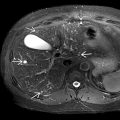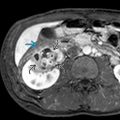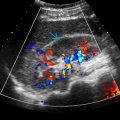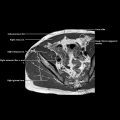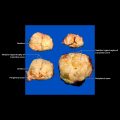KEY FACTS
Terminology
- •
Deep vein thrombosis (DVT), pulmonary embolism (PE), venous thromboembolism (VTE)
- •
Deep vein thrombosis (DVT): Thrombus forms within deep venous system, typically in lower limbs
Imaging
- •
Complete compression ensures no thrombus is present
- •
Thrombus becomes more echogenic as it ages, as well as more linear and cord-like as chronic process
- •
Chronic sequelae of thrombus can cause scarring, decrease in vessel lumen, and chronic reflux and stasis
- •
Loss of respiratory phasicity is suggestive of obstruction closer to heart
- •
Augmentation (↑ in flow velocity with distal compression)
- ○
Poor augmentation suggests downstream obstruction
- ○
- •
Acute thrombosis (~ 14 days)
- ○
Thrombus hypoechoic, may distend vein if occlusive
- ○
May see free-floating thrombus
- ○
Collateralization: Tortuous and braided collateral veins, usually smaller than normal vein
- ○
Associated slow flow may be seen as visible mobile echoes moving back and forth in real time/cine clip
- ○
- •
Subacute thrombosis (~ 2 weeks to 6 months)
- ○
Thrombus becomes more echogenic, variable
- ○
Luminal flow may be restored or vein may stay occluded
- ○
Collateral venous channel continues to develop
- ○
- •
Chronic phase (≥ 6 months)
- ○
Postthrombotic scarring forms
- ○
Scarred veins are thick-walled with reduced diameter
- ○
Plaque-like fibrous scars, synechiae form along vein periphery and may occasionally calcify
- ○
Synechiae: Formed from unlysed thrombus that is attached to one side of vein wall and gradually transformed into fibrous band
- ○
Fibrous cord: In nonrecannalized vein, vein reduced to echogenic cord smaller than normal vein
- ○
Valve abnormalities
- ○
Clinical Issues
- •
Most are treated with anticoagulation or IVC filter, with thrombolysis having role in severe situations
- •
Important to assess if there is any history of prothrombotic risk (congenital or acquired)
Scanning Tips
- •
Perivascular edema may mimic nonocclusive thrombus especially on compression views; however, look for smooth echogenic intima of vein, which is often more prominent with perivascular edema
- •
Femoral vein (FV) and popliteal veins are often duplicated
- •
If 9 linear transducer is not able to penetrate to level of vein due to patient body habitus or limb swelling, try curvilinear probe
- •
Refractive edge shadow from fascial planes may obscure distal FV; slightly anterior/medial approach using vastus medialis muscle as acoustic window may help visualization
- •
Calcified arteries may obscure visualization of adjacent deep vein and create pseudo filling defect on color Doppler images; avoid using adjacent artery as acoustic window in these patients

